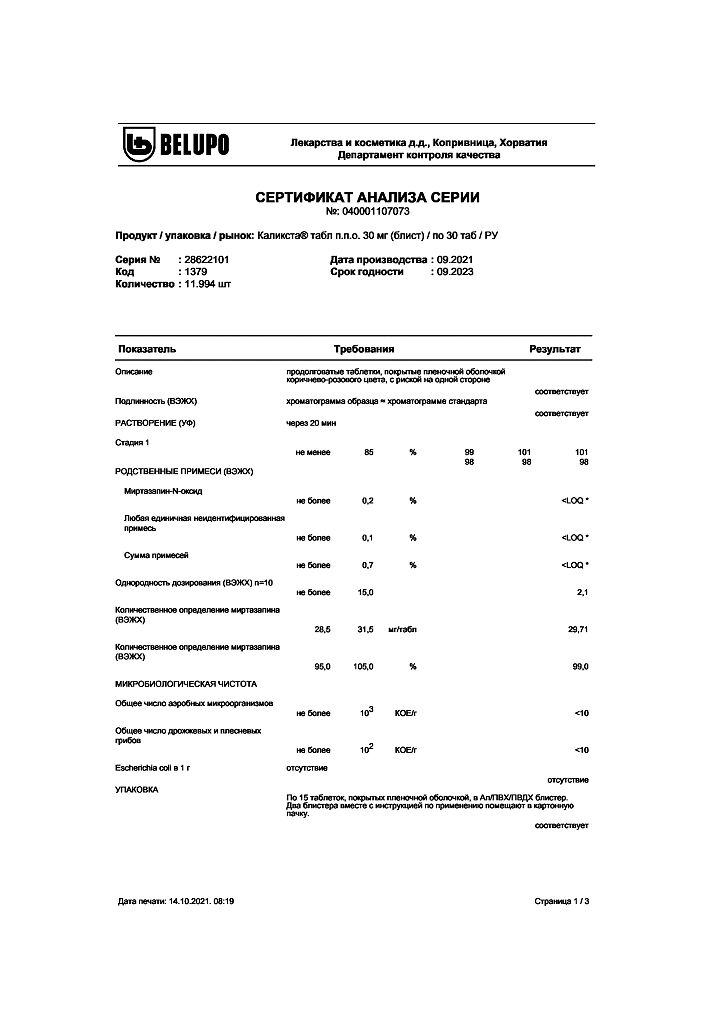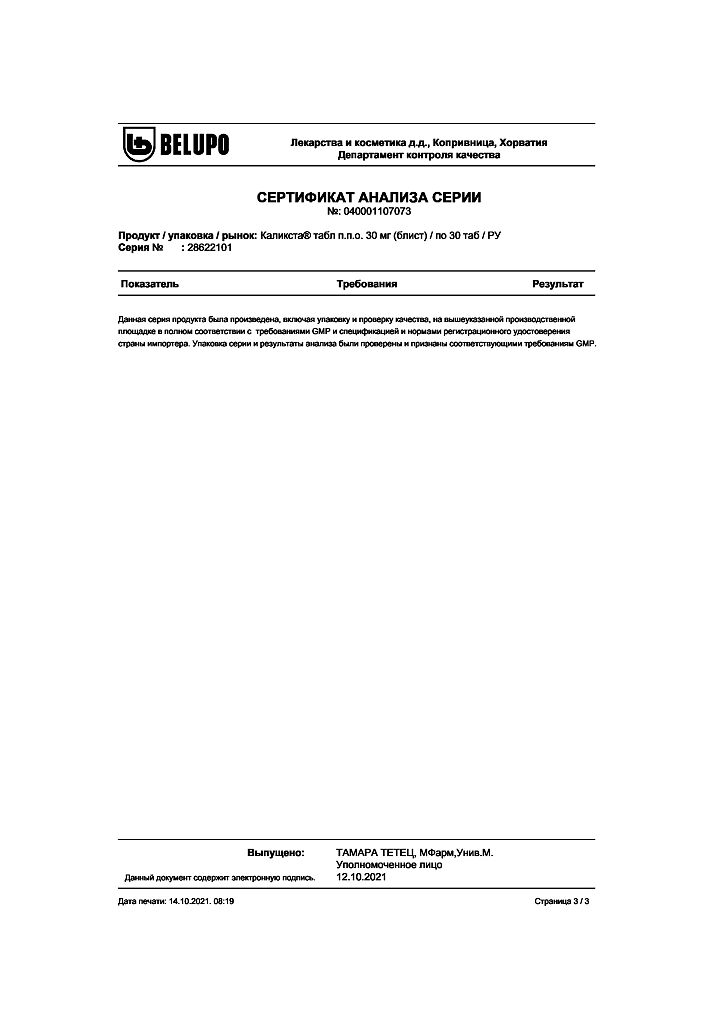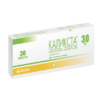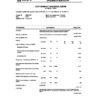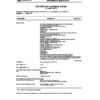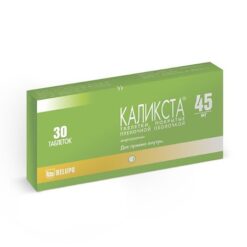No products in the cart.
Calixta, 30 mg 30 pcs
€44.28 €36.90
Description
Mirtazapine is an antagonist of presynaptic α2-adrenoreceptors in the CNS and increases central noradrenergic and serotonergic transmission of nerve impulses. However, the enhancement of serotonergic transmission is realized only through serotonin 5-HT1 receptors, because mirtazapine blocks serotonin 5-HT2- and 5-HT3-receptors. Both enantiomers of mirtazapine are thought to have antidepressant activity, the S(+) enantiomer by blocking α2-adreno- and serotonin 5-NT2-receptors, the aR(-) enantiomer by blocking serotonin 5-NT3-receptors.
Mirtazapine’s sedative properties are due to its antagonistic activity toward H1-histamine receptors.
Mirtazapine is generally well tolerated. At therapeutic doses, it has almost no m-cholinergic effect and almost no effect on the cardiovascular system.
Pharmacokinetics
Mirtazapine is rapidly absorbed after oral administration (about 50% bioavailability), reaching Cmax in plasma after approximately 2 hours. About 85% Mirtazapine is bound to plasma proteins. The average T1/2 is 20 to 40 h (rarely up to 65 h). A shorter T1/2 is observed in young people. The equilibrium concentration of the substance is reached after 3-4 days and thereafter it does not change.
In the recommended dose range, the pharmacokinetic parameters of Mirtazapine have a linear dependence on the administered dose of the drug. Food intake has no effect on the pharmacokinetics of the drug. Mirtazapine is actively metabolized and excreted in the urine and feces within a few days. Its main pathways of metabolism in the body are demethylation and oxidation followed by conjugation. Cytochrome P450 isoenzymes (CYP2D6 and CYP1A2) are involved in the formation of the 8-hydroxy metabolite Mirtazapine, while CYP3A4 presumably determines the formation of N-demethylated and N-oxidized metabolites.
Demethylmirtazapine is pharmacologically active.
The clearance of Mirtazapine is decreased in renal or hepatic insufficiency.
Indications
Indications
Depression.
Pharmacological effect
Pharmacological effect
Mirtazapine is an antagonist of presynaptic α2-adrenergic receptors in the central nervous system and enhances central noradrenergic and serotonergic transmission of nerve impulses. In this case, the enhancement of serotonergic transmission is realized only through serotonin 5-HT1 receptors, since mirtazapine blocks serotonin 5-HT2 and 5-HT3 receptors. It is believed that both enantiomers of Mirtazapine have antidepressant activity, the S(+) enantiomer by blocking α2-adrenergic and serotonin 5-HT2 receptors, the aR(-) enantiomer by blocking serotonin 5-HT3 receptors.
The sedative properties of Mirtazapine are due to its antagonistic activity towards H1-histamine receptors.
Mirtazapine is generally well tolerated. In therapeutic doses, it has virtually no m-choline-blocking effect and has virtually no effect on the cardiovascular system.
Pharmacokinetics
After oral administration of the drug, Mirtazapine is rapidly absorbed (bioavailability about 50%), reaching Cmax in the blood plasma after approximately 2 hours. About 85% of Mirtazapine is bound to plasma proteins. The average T1/2 ranges from 20 to 40 hours (rarely up to 65 hours). A shorter T1/2 is observed in young people. The equilibrium concentration of the substance is achieved after 3-4 days and subsequently does not change.
In the recommended dose range, the pharmacokinetic parameters of Mirtazapine have a linear dependence on the administered dose of the drug. Food intake does not affect the pharmacokinetics of the drug. Mirtazapine is extensively metabolized and excreted in urine and feces over several days. The main pathways of its metabolism in the body are demethylation and oxidation followed by conjugation. Cytochrome P450 isoenzymes (CYP2D6 and CYP1A2) are involved in the formation of the 8-hydroxy metabolite of Mirtazapine, while CYP3A4 presumably determines the formation of N-demethylated and N-oxidized metabolites.
Demethylmirtazapine is pharmacologically active.
The clearance of Mirtazapine is reduced in cases of renal or hepatic insufficiency.
Special instructions
Special instructions
When using the drug Calixta, you should keep in mind:
– Worsening of psychotic symptoms may occur when antidepressants are used to treat patients with schizophrenia or other psychotic disorders; Paranoid ideas may increase.
— The depressive phase of manic-depressive psychosis during treatment can transform into a manic phase.
– In young people (under 24 years of age) with depression and other mental disorders, antidepressants, compared with placebo, increase the risk of suicidal thoughts and behavior. Therefore, when prescribing Calixta to young people (under 24 years of age), the risk of suicide should be weighed against the benefits of using the drug. In short-term studies, the risk of suicide did not increase in people over 24 years of age, and the risk of suicide decreased slightly in people over 65 years of age. Any depressive disorder itself increases the risk of suicide. Therefore, during treatment, the patient should be monitored to identify disturbances or changes in behavior, as well as suicidal tendencies.
— Despite the fact that the drug Calixta is not addictive, based on their post-registration experience, it turned out that abrupt cessation of treatment after prolonged use can sometimes cause withdrawal symptoms. Most withdrawal reactions are mild and self-limiting. The most commonly reported withdrawal symptoms were dizziness, agitation, anxiety, headache and nausea. Although these have been reported as withdrawal symptoms, it should be understood that these symptoms may be related to an underlying medical condition. It is recommended that treatment with mirtazapine be discontinued gradually.
– Elderly patients are usually more sensitive, especially to side effects. In clinical studies of Calixta, it was not noted that side effects were more common in elderly patients than in other age groups, but they may be more pronounced, but data are still limited.
– If signs of jaundice appear, treatment should be stopped.
— Patients are advised to avoid alcohol while being treated with Calixta.
– Bone marrow suppression, usually appearing as granulocytopenia or agranulocytosis, is rarely observed with the use of Calixta. Appears mostly after 4-6 weeks of treatment and is reversible after cessation of treatment. The doctor should pay close attention to symptoms such as fever, sore throat, stomatitis, and other signs of influenza-like syndrome and inform the patient about this; If such symptoms appear, you should stop treatment and do a blood test.
Impact on the ability to drive vehicles and machinery
Calixta may reduce concentration. During treatment with antidepressants, patients should avoid performing potentially dangerous activities that require high speed psychomotor reactions, such as driving a car or operating machinery.
Active ingredient
Active ingredient
Mirtazapine
Composition
Composition
Active ingredient:
mirtazapine 15 mg.
Excipients:
lactose monohydrate – 44.4 mg,
corn starch – 28 mg,
hyprolose – 15 mg,
microcrystalline cellulose – 15 mg,
pregelatinized starch – 15 mg,
talc – 1.4 mg,
magnesium stearate – 0.7 mg,
silicon dioxide – 0.5 mg.
Shell composition:
hypromellose-5 CPS – 2.4 mg, macrogol 6000 – 0.2 mg, titanium dioxide – 0.25 mg, iron dye yellow oxide (E172) – 0.1 mg, talc – 0.05 mg.
Pregnancy
Pregnancy
The safety of using Calixta during pregnancy in humans has not been established, but no teratogenic effect has been detected in animals, so the drug can be used during pregnancy only if the benefit to the mother outweighs the potential risk to the fetus.
The use of Calixta during lactation is not recommended due to the lack of data on its excretion in human breast milk.
Contraindications
Contraindications
– patients with rare hereditary problems such as lactose intolerance, lactase deficiency or glucose-galactose malabsorption should not be prescribed Calixta;
– hypersensitivity to mirtazapine or to any of the excipients;
— since the safety and effectiveness of the drug Calixta for children have not been established, the use of the drug Calixta for the treatment of children under 18 years of age is not recommended.
With caution:
Like other antidepressants, Calixta should be used with caution in the following cases:
– acute angle-closure glaucoma and increased intraocular pressure;
– diabetes mellitus;
– urinary disturbances, incl. with prostatic hyperplasia;
– with simultaneous use of benzodiazepines with the drug Calixta.
Correction of the dosage regimen and regular medical monitoring are necessary for the following categories of patients:
– patients with epilepsy and organic brain lesions (during treatment with Calixta, in rare cases, seizures may develop);
– patients with liver or kidney failure;
– patients with heart disease (conduction disorders, angina pectoris or recent myocardial infarction);
— patients with cerebrovascular diseases (including a history of ischemic stroke);
– patients with arterial hypotension and with conditions predisposing to arterial hypotension (including dehydration and hypovolemia);
– patients who abuse drugs, are dependent on drugs that affect the central nervous system, with mania, hypomania.
Side Effects
Side Effects
From the gastrointestinal tract: very often – dry mouth; often – nausea, diarrhea, vomiting; infrequently – decreased sensitivity of the oral mucosa; frequency not established – swelling of the oral mucosa.
From the blood and lymphatic system: frequency not established – bone marrow suppression (granulocytopenia, agranulocytosis, aplastic anemia and thrombocytopenia), eosinophilia.
From the nervous system: very often – drowsiness (which can lead to impaired concentration), usually occurring during the first weeks of treatment. (N.B. dose reduction does not usually result in less sedation, but may reduce the effectiveness of the antidepressant), sedation, headache; often – lethargy, dizziness, tremor; infrequently – paresthesia, restless legs syndrome, fainting; rarely – myoclonus, very rarely – convulsions (stroke), serotonin syndrome, paresthesia of the oral mucosa.
From the skin and subcutaneous tissues: often – skin rash.
From the musculoskeletal system and connective tissue: often – arthralgia, myalgia, back pain.
From the endocrine system: frequency not established – impaired secretion of antidiuretic hormone.
Metabolism and nutrition: very often – increased appetite.
From the cardiovascular system: often – orthostatic hypotension; infrequently – decreased blood pressure.
General disorders and disorders at the injection site: often – local edema; infrequently – fatigue.
From the liver and biliary tract: rarely – increased activity of serum transaminases.
Mental disorders: often – unusual dreams, confusion, anxiety*, insomnia*, infrequently – nightmares, mania, agitation, hallucinations, psychomotor agitation (including akatasia and hyperkinesia); frequency not established – suicidal ideation, suicidal behavior. *usually with antidepressant treatment, anxiety and insomnia, which can be symptoms of depression, may develop or worsen.
The development or worsening of anxiety and insomnia has been reported very rarely during treatment with Calixta.
Interaction
Interaction
Pharmacodynamic interaction
Mirtazapine should not be used in combination with MAO inhibitors or within two weeks of stopping treatment with a MAO inhibitor.
Mirtazapine may enhance the sedative properties of benzodiazepines and other sedatives. Caution should be exercised when prescribing these drugs with mirtazapine.
Mirtazapine may enhance the depressive effects of alcohol on the central nervous system. Therefore, patients should be warned to avoid drinking alcohol.
When other serotonergic medicinal products (eg selective serotonin uptake inhibitors and venlafaxine) are used in combination with mirtazapine, there is a risk of interaction which may lead to the development of serotonin syndrome.
Mirtazapine at a dose of 30 mg 1 time / day caused a small but statistically significant increase in INR (international normalized ratio) in subjects treated with warfarin. A more pronounced effect with a higher dose of mirtazapine cannot be excluded. It is recommended to monitor MHO in case of treatment with warfarin in combination with mirtazapine.
Mirtazapine is extensively metabolized by the CYP2D6 and CYP3A4 isoenzymes, and to a lesser extent by the CYP1A2 isoenzyme. An interaction study in healthy volunteers showed that paroxetine, an inhibitor of the CYP2D6 isoenzyme, has no effect on the pharmacokinetics of mirtazapine at steady state. Administration in combination with a strong CYP3A4 inhibitor, ketoconazole, increased the maximum plasma concentration and AUC of mirtazapine by approximately 40% and 50%, respectively.
Caution should be exercised when mirtazapine is used in combination with strong CYP3A4 inhibitors, HIV protease inhibitors, azole antifungals, erythromycin, or nefazodone. Carbamazepine and phenytoin, inducers of the CYP3A4 isoenzyme, increased the clearance of mirtazapine by approximately twofold, which led to a 45-60% decrease in plasma concentrations of mirtazapine.
When carbamazepine or another liver microsomal enzyme inducer (eg, rifampicin) is added to mirtazapine therapy, the dose of mirtazapine should be increased if necessary.
If treatment with this drug is stopped, the dose of mirtazapine may need to be reduced. When mirtazapine is used in combination with cimetidine, the bioavailability of mirtazapine may increase by more than 50%. The dose of mirtazapine should be reduced if necessary when starting treatment in combination with cimetidine or increased when treatment with cimetidine is discontinued.
In in vivo interaction studies, mirtazapine had no effect on the pharmacokinetics of risperidone or paroxetine (CYP2D6 substrate), carbamazepine (CYP3A4 substrate), amitriptyline, cimetidine, or phenytoin. No important clinical effects or changes in pharmacokinetics were observed in humans when treated with mirtazapine in combination with lithium.
Overdose
Overdose
In case of overdose, symptomatic therapy should be carried out to maintain vital body functions.
Activated charcoal should be administered or the stomach should be rinsed. Current experience with overdose with Calixta alone indicates that symptoms are usually mild. CNS depression has been reported, accompanied by disorientation and prolonged sedation in combination with tachycardia and a slight increase or decrease in blood pressure.
However, there is a potential for more severe results (including death) at doses much higher than the therapeutic dose, particularly in overdoses of multiple drugs taken at the same time.
Storage conditions
Storage conditions
Store the drug out of the reach of children at a temperature not exceeding 25°C.
Shelf life
Shelf life
2 years.
Manufacturer
Manufacturer
Belupo, medicines and cosmetics d.d., Croatia
Additional information
| Shelf life | 2 years. |
|---|---|
| Conditions of storage | The drug should be kept out of reach of children at a temperature not exceeding 25 ° C. |
| Manufacturer | Belupo,medicines and cosmetics d.d., Croatia |
| Medication form | pills |
| Brand | Belupo,medicines and cosmetics d.d. |
Other forms…
Related products
Buy Calixta, 30 mg 30 pcs with delivery to USA, UK, Europe and over 120 other countries.


